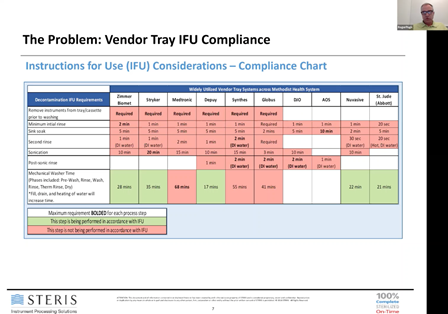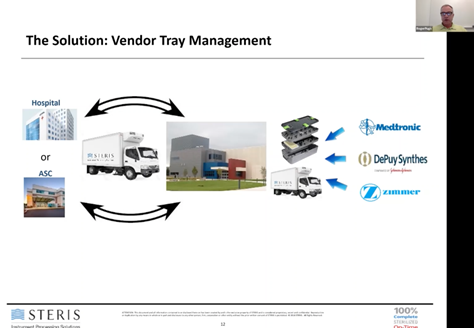STERIS Associates Discuss Outsourcing Sterilization Process to Prevent Infection
STERIS Associates Discuss Outsourcing Sterilization Process to Prevent Infection
By Tara Phipps
On Thursday, April 22, two STERIS associates discussed offsite reprocessing centers and issues ambulatory surgery centers face with vendor trays at the bi-weekly Texas Ambulatory Surgery Center Society town hall event.
Nancy Struzziero, vice president of strategic alliances for STERIS’s instrument processing division, presented major trends, issues in the sterilization industry and solutions with her colleague, Roger Pugh, who handles business development from Alabama to the West Coast, where he focuses on offsite reprocessing.
STERIS is a large company that provides global reprocessing services, with over 54 facilities across Europe, Asia and the United States. The company works to reprocess over 90 million instruments a year, and the division Struzziero and Pugh work for focuses on onsite and offsite reprocessing services globally.
Pugh, who has experience running sterile processing departments, spoke to major trends in the industry including labor shortages, increase in surgeries that require more complex trays and tighter regulation enforcement. The solution to all these issues, Pugh and Struzziero explained, is STERIS offsite reprocessing centers.
The most significant issue Pugh brought up to TASCS members is Instruction For Use (IFU) Compliance.

Pugh referenced a compliance chart from an actual hospital system where the IFUs highlighted in red represented noncompliance. With a lot of surgeries transitioning out of hospitals and into ASCs, the big question Pugh wanted to answer was how to get these systems compliant.
“It’s gonna require more space, more equipment and more people to push this thing through,” Pugh said.
Centers for Medicare and Medicaid Services (CMS) proposed the removal of 300 procedures from the inpatient-only list, with 266 to be removed at the start of 2021. This only furthers the spatial and IFU compliance issues Pugh emphasized throughout the presentation.
STERIS offsite reprocessing centers were proposed as a solution to these problems. Pugh spoke to both permanent buildings and mobile units that would help relieve the stress of increased volume, as more surgeries transition to ASCs.
The offsite reprocessing operation would entail a temperature-controlled truck that would take the trays from an ASC to an offsite reprocessing center to be sterilized. The trays would be placed in transportation carts on their way to the sterilization center and then sealed in plastic covers that would keep humidity out and dust off for their return.

The other solution they discussed was mobile sterilization processing, with a much smaller capacity for work but larger potential to reduce contamination and support the OR during construction or renovation.
“What we are trying to do is start with a smaller unit like that mobile ORC, and it’s something we can build in a much faster time,” Struzziero said.
The mobile units could accommodate about 125 trays a day, whereas STERIS’s traditional ORCs could accommodate 900 trays a day.
Struzziero went on to explain a pilot program STERIS launched with a vendor and compared pre-pilot and pilot procedure disruptions such as a hole in the wrap or missing instruments. Without using STERIS offsite reprocessing centers, the vendor experienced about 39% of tray disruptions. After STERIS took over, that number went down to 7.5%.
“There’s really a benefit to their customer and to themselves,” Struzziero said.
STERIS has also invested in visual management software that cross-references the different instruments in a tray and moves the IFU to the highest levels of the sterilization process to ensure proper cleanliness.
In order to secure standard work and quality management, STERIS has developed a playbook to regulate the sterile processing experience and avoid those disruptions.
“This is something kind of cool. We’ve been working on this for about seven years,” Pugh said. “It’s called a playbook and our thought process is we want to be process-driven and people-driven.”
Every facility runs the same way no matter where it is in the country because of the investment in the STERIS Instrument Processing Playbook.
When asked about their work with accrediting organizations, Pugh answered the primary source was the DNV.
“We feel like DNV is a little bit of a deeper dive than the Joint Commission would be,” Pugh said. “Each one of our facilities goes through a DNV certification process.”
STERIS and its vendors are primarily looking to the ASC marketplace for investment, as these centers continue to grow, so they can keep up with sterilization, customer care and surgeon satisfaction.

